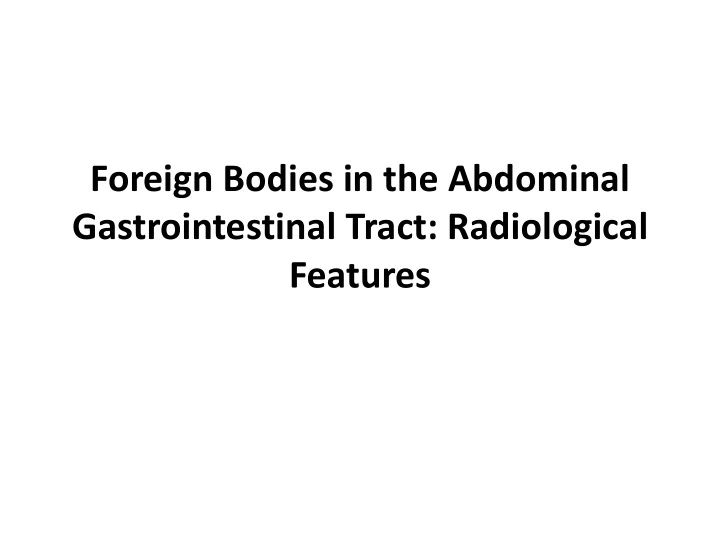

Foreign Bodies in the Abdominal Gastrointestinal Tract: Radiological Features
Purpose • To present the clinical and radiological features associated with foreign bodies along the abdominal gastrointestinal tract
Methods • Consecutive patients with foreign bodies in their abdominal alimentary tract were retrospectively collected (2009-2016)
Methods • The foreign bodies were divided into seven categories: – Medical Devices – Fish Bones – Elongated Metal Objects – Dental Related Objects – Drugs – “body packers” – Intra-rectal Objects – and Glass
Methods • Two radiologists analyzed all radiological examinations in consensus, evaluating which objects were missed on X-ray and registering foreign bodies shapes and complications
Methods • The different foreign bodies categories were statistically compared (chi-square test with post-hoc evaluation) with: – clinical suspicion – X-ray visualization – Presence of complications – and need for removal
Results • 42 patients were included. Categories: – medical devices: 4 – fish bones: 3 – Elongated metal: 5 – Dental: 22 – Drugs: 3 – Intra-rectal: 3 – And glass: 2
Results • Thirty-eight patients underwent X-ray and 14 underwent CT
Results • Clinical suspicion was significantly higher in the dental category (p=0.002) and lower in the fish bones (p<0.001) and metal (p=0.005) categories
Results • The complication rate was higher in the medical devices, metal, fish bones and drugs categories and significantly lower in the dental category (p=0.002) • The only mortality case was due to cocaine absorption in a “body packer”
Results • Fish bones were significantly less likely to be identified in x-ray (p=0.005). Dental, intra- rectal
38 y.o women. Abdominal XR shows retained gauze from a hemorrhoidectomy. Notice the gauze have migrated to the descending colon. It was removed by colonoscopy.
51 y.o. man. Sagittal CT image shows colonic perforation and formation of a large abdominal wall abscess due to a fish bone .
36 y.o. woman. X-ray showing a swallowed dental bridge . This was followed conservatively.
48 y.o. man. Swallowed dental crown , also followed conservatively.
53 y.o. man with Crohn’s disease . Coronal CT image shows a dental bridge (short arrow) causing obstruction in a stenotic terminal ileum (long arrow)
53 y.o. man with Crohn’s disease. X-ray shows the dental bridge
18 y.o. man with swallowed dental brackets followed conservatively.
47 y.o. man. X-ray shows an Intra-rectal perfume bottle . Object was removed in surgery.
19 y.o. woman with psychiatric disorder. Intentional swallow of glass shreds . Objects were followed conservatively.
Conclusion • Having sound knowledge in the abilities of different imaging modalities in visualizing foreign bodies, as well as understanding how different foreign bodies present, both clinically and radiologically, is important when looking for foreign bodies or their complications
Recommend
More recommend